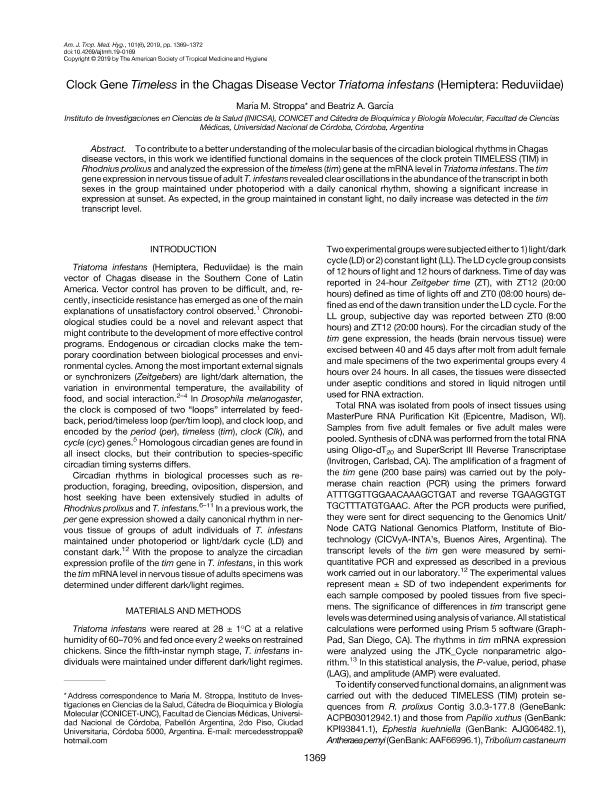Mostrar el registro sencillo del ítem
dc.contributor.author
Stroppa, Maria Mercedes

dc.contributor.author
Garcia, Beatriz Alicia

dc.date.available
2021-02-12T16:48:03Z
dc.date.issued
2019-11
dc.identifier.citation
Stroppa, Maria Mercedes; Garcia, Beatriz Alicia; Clock gene timeless in the chagas disease vector Triatoma infestans (Hemiptera: Reduviidae); American Society of Tropical Medicine and Hygiene; American Journal of Tropical Medicine and Hygiene; 101; 6; 11-2019; 1369-1372
dc.identifier.issn
0002-9637
dc.identifier.uri
http://hdl.handle.net/11336/125594
dc.description.abstract
To contribute to a better understanding of the molecular basis of the circadian biological rhythms in Chagas disease vectors, in this work we identified functional domains in the sequences of the clock protein TIMELESS (TIM) in Rhodnius prolixus and analyzed the expression of the timeless (tim) gene at the mRNA level in Triatoma infestans. The tim gene expression in nervous tissue of adult T. infestans revealed clear oscillations in the abundance of the transcript in both sexes in the group maintained under photoperiod with a daily canonical rhythm, showing a significant increase in expression at sunset. As expected, in the group maintained in constant light, no daily increase was detected in the tim transcript level.
dc.format
application/pdf
dc.language.iso
eng
dc.publisher
American Society of Tropical Medicine and Hygiene

dc.rights
info:eu-repo/semantics/openAccess
dc.rights.uri
https://creativecommons.org/licenses/by-nc-sa/2.5/ar/
dc.subject
CHAGAS DISEASE
dc.subject
TRIATOMA INFESTANS
dc.subject
CLOCK GENES
dc.subject
TIMELESS
dc.subject.classification
Bioquímica y Biología Molecular

dc.subject.classification
Ciencias Biológicas

dc.subject.classification
CIENCIAS NATURALES Y EXACTAS

dc.title
Clock gene timeless in the chagas disease vector Triatoma infestans (Hemiptera: Reduviidae)
dc.type
info:eu-repo/semantics/article
dc.type
info:ar-repo/semantics/artículo
dc.type
info:eu-repo/semantics/publishedVersion
dc.date.updated
2020-11-19T21:10:42Z
dc.journal.volume
101
dc.journal.number
6
dc.journal.pagination
1369-1372
dc.journal.pais
Estados Unidos

dc.journal.ciudad
Stanford
dc.description.fil
Fil: Stroppa, Maria Mercedes. Consejo Nacional de Investigaciones Científicas y Técnicas. Centro Científico Tecnológico Conicet - Córdoba. Instituto de Investigaciones en Ciencias de la Salud. Universidad Nacional de Córdoba. Instituto de Investigaciones en Ciencias de la Salud; Argentina. Universidad Nacional de Córdoba. Facultad de Medicina. Cátedra de Bioquímica y Biología Molecular; Argentina
dc.description.fil
Fil: Garcia, Beatriz Alicia. Universidad Nacional de Córdoba. Facultad de Medicina. Cátedra de Bioquímica y Biología Molecular; Argentina. Consejo Nacional de Investigaciones Científicas y Técnicas. Centro Científico Tecnológico Conicet - Córdoba. Instituto de Investigaciones en Ciencias de la Salud. Universidad Nacional de Córdoba. Instituto de Investigaciones en Ciencias de la Salud; Argentina
dc.journal.title
American Journal of Tropical Medicine and Hygiene

dc.relation.alternativeid
info:eu-repo/semantics/altIdentifier/doi/http://dx.doi.org/10.4269/ajtmh.19-0169
dc.relation.alternativeid
info:eu-repo/semantics/altIdentifier/url/https://www.ajtmh.org/view/journals/tpmd/101/6/article-p1369.xml
dc.relation.alternativeid
info:eu-repo/semantics/altIdentifier/url/https://www.ncbi.nlm.nih.gov/pmc/articles/PMC6896882/
Archivos asociados
